Last week, one of my friends returned from Paris with a copy of Pierre Hermé's Macaron for me. I had been looking for this book for months. For those of you who haven't been consumed by macaron obsession, Hermé is the man when it comes to macarons, and his book--a trove of wild and wonderful variations--is a classic, though sadly out of print and very difficult to get in North America. My friend scoured five bookstores in Paris and finally found a copy at Hermé's bakery. Thank you--you know who you are.
The book, as expected, is spectacular. You could pour over it for hours, just marvelling at the photography and imagining what each macaron might taste like. There are classics, like rose, pistachio, and lemon, and more non-traditional pairings like olive oil and vanilla. And then there are the macarons that I could only dream of making, like the one featuring a 25-year-old balsamic vinegar or the black truffle macaron. Just wild.
As you might imagine, it was hard to decide where to start. I wanted to make something interesting but not overly complicated. And whatever it was going to be, I wanted to make it soon. That ruled out a number of options--even some of the traditional macarons call for some hard-to-come-by ingredients. For example, the cassis macaron--I don't expect to find food-grade titanium dioxide at any grocery store that I know of. It's an industrial compound used to make things brilliantly white, like marshmallows. There are a few American suppliers, but I'm not sure that they'll sell anything but huge quantities of the stuff, being industrial suppliers. [Update 2013-04-20: I was poking around L'Epicerie, my go-to online merchant for hard-to-find ingredients, and found that they now sell food-grade titanium dioxide! I was one of a few people who e-mailed them a while ago and requested that they stock it. So, you're welcome.] Of course, the titanium dioxide isn't necessary to the cassis macaron, but if you're going to do macarons à l'Hermé, you may as well go all the way, so I might still look into this.
Eventually, I decided on the macaron praliné à l'ancienne--that is, the traditional praline macaron. What made up my mind was this. To make the filling, you make a French praline--a dark, caramel candy made with just sugar, water, vanilla bean, and whole hazelnuts--pour it out onto a half-sheet, grind it to a powder, and then incorporate it into a sort-of buttercream. Just awesome.
A few notes on the process. First, the macarons that I've made to date started with a French meringue, where you simply whip egg whites with granulated sugar to stiff peaks--no problem with a good whisk and a copper bowl. Hermé's macarons, however, call for an Italian meringue, where you cook a sugar syrup until it reaches 118 degrees C and then incorporate that into partially beaten whites until they form peaks--not something you can really do by hand, not without a second pair of hands and not when your arms are noodles, anyway. I borrowed another friend's stand mixer. And apart from the terror of pouring hot sugar into egg whites going at high speed, the meringue turned out just fine.
Second, because I don't exactly have an eye for uniformity, my boyfriend and I made ourselves a template to make the most of the macaron batter. We measured a sheet of poster board to fit our half-sheets, calculated how many 3.5 cm macarons could fit spaced out 2 cm from one another, drew up a grid that marked the centre of each shell, and then drew out the circles with a compass. When it came time to do the piping, I put the template down on the half-sheet, laid my silicone mat over top, and piped out beautiful, uniformly sized shells. Then it was just a matter of carefully pulling the template out from underneath the mat. Well worth the extra effort.
Third, don't make the praline cream on a hot day. It happened to be inhumanly hot in Chicago on Tuesday--and especially in my apartment--which meant that the cold butter, which was supposed to beat into something light and airy, just got soupy in the bowl of the stand mixer. If this happens to you, incorporate the meringue (yes, you make not one but two Italian meringues for these macarons) into the praline butter as instructed and then cover it and let it stiffen up in the freezer for 15-20 minutes. It should then be of a good consistency for piping onto the shells.
Finally, Hermé's book is entirely in French, so I had to translate the recipe. My grade-school French was helpful for the first time in years (hooray for mandatory second-language classes), but I'm not at all familiar with French baking jargon. I relied a lot on David Lebovitz's translation of another Hermé recipe to fill in the gaps. Please let me know if you spot any egregious errors, though I'm pretty confident that I have nearly everything right. The macarons, after all, turned out splendidly--intensely nutty and bittersweet, with the right balance of delicateness and chew. Definitely the best macarons I've made to date.
For some general macaron pointers, check out this older post.
For some general macaron pointers, check out this older post.
Macaron Praliné à L'ancienne
Adapted from Pierre Hermé's Macaron
Adapted from Pierre Hermé's Macaron
Note: Special equipment. You will definitely need a mixer of some sort to make the Italian meringue. You will also need a candy or probe thermometer that reaches 250 degrees F, three heavy-duty half-sheets, a scale, and a food processor.About the aged egg whites. Hermé recommends that a week before you plan to make the macarons you separate the requisite amount of egg white from the yolks and age them in the fridge. Place them in a small container, cover it with plastic wrap, and puncture the plastic a few times with a sharp knife. After four to seven days in the fridge, the whites will lose their elasticity, making them easier to whip up and less likely to get over-beaten and dry. About the praline. It comes together very quickly--probably in about 7 or 8 minutes from when you start heating up the sugar and water, so don't step away from the pot, even for a moment. I was a little slow in getting the praline out of the pot--another second or two and I would have burned the sugar and had to start over. You'll know your praline is ready to come out of the pot when the syrup, which should be amber and clear after you've added the hazelnuts, turns slightly milky. It'll get dark very quickly after this, so be prepared to pour out the praline out onto your half-sheet just a few seconds after this. About the baking time. Hermé calls for the shells to be baked for 12 minutes. However, my first batch of shells came out underdone. This might be due to my finicky old oven, so I advise checking your oven temperature's accuracy. Slightly over-baked macarons are salvageable--they just need to mature in the fridge for longer than 24 hours. Underdone macarons will have sticky bottoms and won't lift off your parchment.
Shells
75 g almonds, powdered
75 g whole hazelnuts, with skin
150 g powdered sugar
55 g aged egg whites, at room temperature
+
150 g granulated sugar
37.5 g water
55 g aged egg whites, at room temperature
+
30 g whole hazelnuts, with skin
75 g whole hazelnuts, with skin
150 g powdered sugar
55 g aged egg whites, at room temperature
+
150 g granulated sugar
37.5 g water
55 g aged egg whites, at room temperature
+
30 g whole hazelnuts, with skin
Praline Cream
125 g whole hazelnuts, with skin
75 g granulated sugar
20 g water
1/4 vanilla bean
125 g butter
50 g aged egg whites, at room temperature
80 g granulated sugar
20 g water
Prepare the praline. Preheat the oven to 170 degrees C / 338 degrees F. Spread out the 125 g + 30 g + 75 g hazelnuts on a baking sheet and slide into the oven. Roast the nuts for about 15 minutes.
Put the hazelnuts into a medium sieve or a colander. Using a clean kitchen towel, roll them against the surface of the sieve to remove their skins. Set aside 75 g for the macaron shells. Put 30 g into a Ziploc bag and crush them into small pieces with a rolling pin. Set aside. Place the remaining hazelnuts in the oven, keeping them warm with the residual heat.
Place 20 g water and 75 g granulated sugar in a small, heavy-bottomed saucepan. Split the 1/4 vanilla bean in two, scrape out the seeds into the saucepan, and add the pod. Bring to a boil over medium-high heat. Keep the sides of the saucepan clean to prevent the sugar from re-crystallising by brushing them with a wet pastry brush. When the syrup reaches 121 degrees C / 250 degrees F, add the warm hazelnuts and remove from heat. Stir just until the sugar looks sandy and then return to the flame, reduced to medium heat. Stir continuously just until a good, dark caramel is achieved. Pour the mixture out onto a baking sheet. Remove the vanilla pod. Let cool. Then grind into a fine powder in the food processor.
Prepare the macaron shells. Powder the 75 g hazelnuts that were set aside in the food processor, adding half the powdered sugar to prevent the nuts from turning into butter. Sift the remaining powdered sugar and the powdered almonds, along with the powdered hazelnuts into a large bowl. Add 55 g aged egg whites but do not mix them in.
Bring the sugar and water to a boil. Keep the sides of the saucepan clean to prevent the sugar from re-crystallising by brushing them with a wet pastry brush. When the syrup reaches 99 degrees C / 210 degrees F, begin whipping the second 55 g portion of egg whites. When the syrup reaches 118 degrees C / 244 degrees F, slowly pour the syrup into the whites, letting the syrup run down the sides of the bowl so that it doesn't splatter. The whites should have barely formed soft peaks at this point. Continue whipping the whites on high speed for one more minute. Reduce the speed of the mixer to medium and continue whipping the whites for about 2 minutes. The whites are ready when they've cooled to 50 degrees C / 122 degrees F. Add the whites to the powdered nut mixture and fold together quickly, in as few strokes as possible. The batter is of the right consistency when it falls off the end of the spatula in a thick ribbon. Put the macaron batter in a pastry bag fitted with a no. 11 tip.
Pipe shells around 3.5 cm in diameter, spaced at least 2 cm apart on a parchment-lined half-sheet (doubled with another half-sheet for insulation). Dust with reserved crushed hazelnuts. Let the shells stand for 30 minutes.
Preheat the oven to 180 degrees C / 356 degrees F. Slide the macaron shells into the oven. Bake for 12-13 minutes, opening the oven door quickly twice towards the end of this time. Let the shells cool for at least 30 minutes before lifting them from the parchment.
Prepare the praline cream. Whip the egg whites to stiff peaks. At the same time, bring 20 g water and 80 g granulated sugar to a boil in a small saucepan. When the syrup reaches 121 degrees C / 250 degrees F, pour it over the egg whites and whip until completely cool.
With the paddle attachment fitted, cream the butter for 5 minutes in the bowl of the stand mixer and then add the praline powder a little bit at a time. Mix for another five minutes.
Gently incorporate 1/3 of the meringue into the praline mixture, then add the rest, again gently.
Fill a pastry bag fitted with a no. 11 tip with the praline cream. Pipe a generous amount of cream on half of the macaron shells. Sandwich these with the remaining shells.
Leave the macarons in the refrigerator for 24 hours. Remove from the refrigerator 2 hours before serving.
Makes about 36 macarons

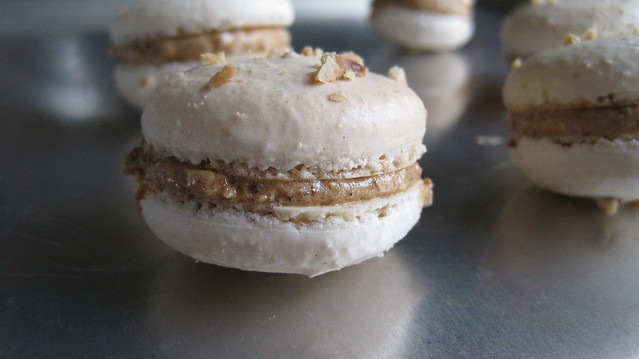
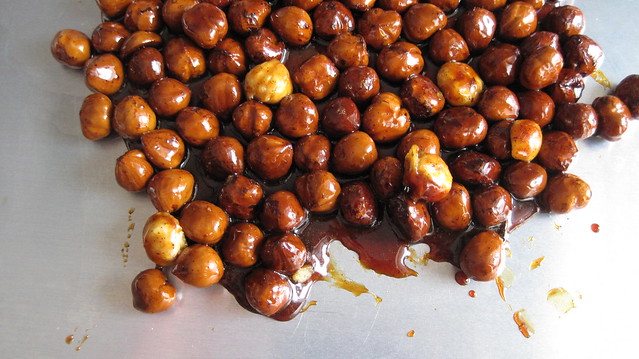
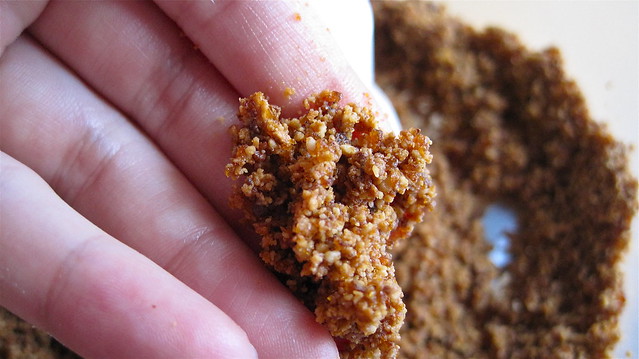
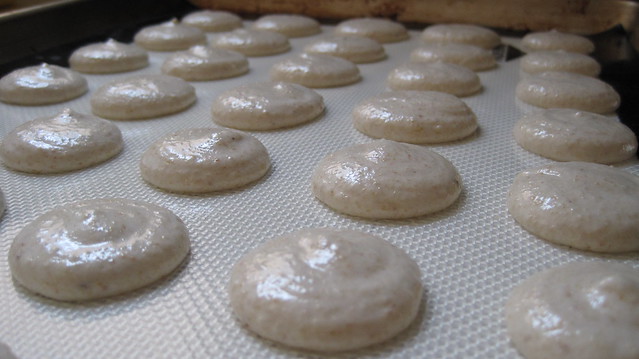
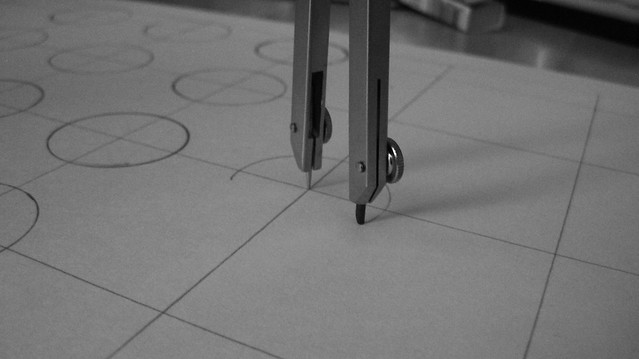
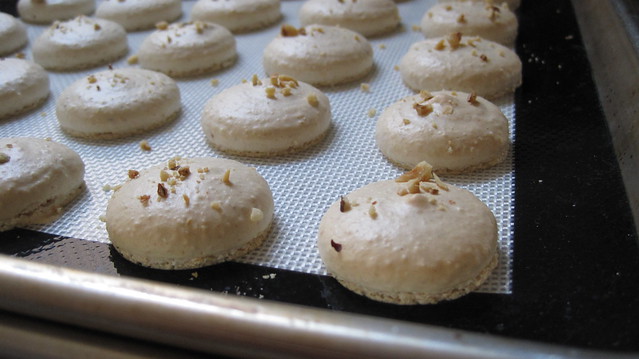
Okay seriously, the mathematical equipment thing rocks. Lol. This recipe looks great Katie.
ReplyDeleteThanks, Oana. It was really all my boyfriend's doing. Hermé recommends making a template, and there's a photo in the book of someone tracing circles around a shot glass, so I was just going to haphazardly draw some circles with a tiny jam jar. But then my boyfriend insisted that we break out the compass and the calculator. I recommend not trying this at 11:30 pm.
ReplyDeleteHello, just found your blog and am in love with all of your photos--as well as the subjects in them! What a nice story and recipe. And how is it that "macaron praliné à l'ancienne" sounds so much better than tradition praline macaron? I'll never know.
ReplyDeleteThank you so much! The French does sound way more elegant than the English, doesn't it? Europeans just have sophistication down pat in a way that we North Americans never will, I suspect...
ReplyDeletewow. i just found your blog from a comment you made on design sponge, and i'm so glad i clicked over! i am totally going to makes these, but am also tempted to just eat the hazelnut praline on it's own...sounds so good.
ReplyDeleteThanks :)
ReplyDeleteI probably should have said something about this in the post, but I definitely had at least a cup of extra praline cream after filling the macarons. Now, this might have been because the cream was still a little too thin (it was really, really hot in the apartment). As a result, I wasn't very generous with the piping--I didn't want to risk over-filling them and have the cream drip all over the sides. If I had let the cream sit in the freezer for five or ten minutes longer, I probably could have topped the shells off with a little more.
But either way, there will be extra for eating by the spoonful. It is, however, very, very rich on its own. I had to split the bowl with a friend with a sweet tooth.
Selling titanium dioxide in small amounts at chocolate craft colors website!
ReplyDelete